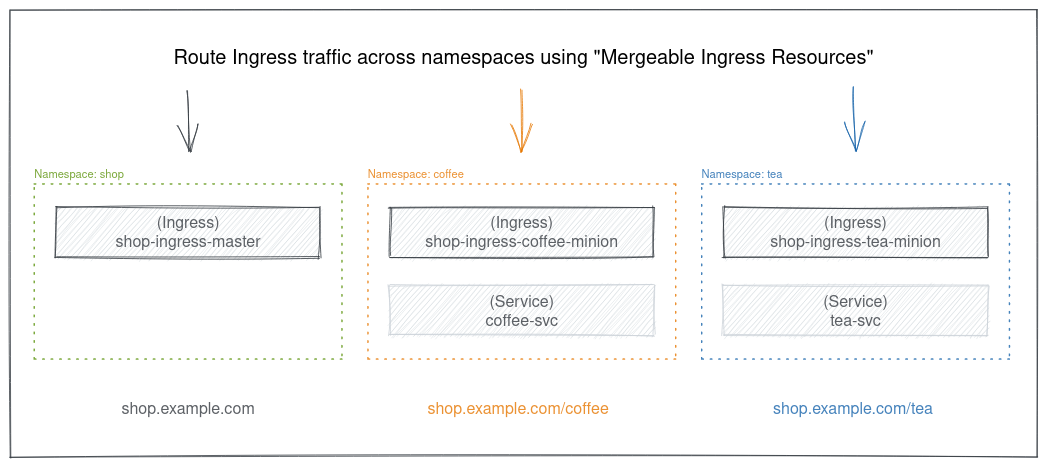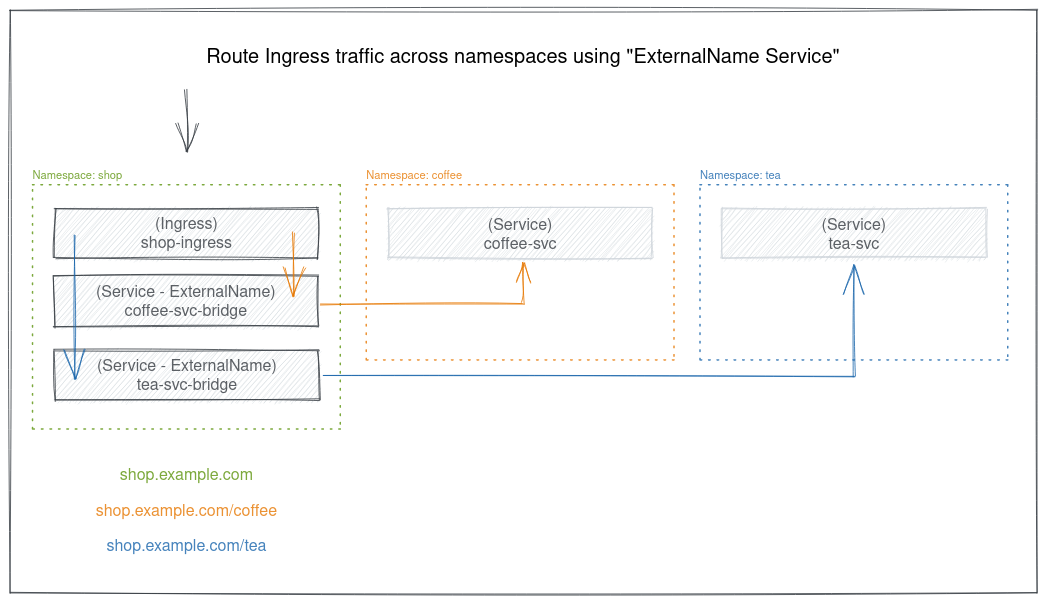2 способа направить трафик Ingress между namespaces - Kubernetes
The tech industry of full of workarounds, you are probably using or relying on some workaround. And there is no problem with that per se. But most important is that when you do a workaround you should be aware of that and change it to the standard way if it's more intuitive.
The ProblemПроблема
A couple of years ago I had a use case where a single domain had 2 sub-paths each of them having its own service in different namespaces. Let's see this example:
Пару лет назад я встретил такую ситуацию когда один домен имел 2 дополнительных маршрута к сервисам которые находились в соседних namespaces. Давайте рассмотрим пример:
example.com/app => service сервис "backend" in namespaceв пространстве "app"
example.com/blog => serviceсервис "wordpress" inв namespaceпространстве "blog".
Проблема problemбыла wasв thatтом, theчто Ingress objectможет isотправлять ableтраффик toв sendсервис trafficвнутри toодного the services within the same namespace only and only oneпространства, ingress objectможет perбыть host/domainтолько was1 allowed.для Butдомен. at aНо certain version (I think that was v1.0.0)дальше Nginx Ingress introducedввели what'sтак known asназываемый Mergeable Ingress Resources. However,Однако, atв thatэто timeже Iвремя wasя workingработал withсо anстарой oldверсией versionкоторая thatне doesn'tподдерживала supportподобного. that
В thereслед wasраз, anя issueнашел Iобщее cannotрешение reallyкоторое recallвыглядит now)как костыли. В общем говоря, это не плохие костыли. В зависимости о том, как вы управляете инфраструктурой, и вы можете смотреть на это как централизованное или нецентрализованное применение .
SoВозможно atдва thatрешения. time I found a generic solution which looks like a workaround. Actually, by thinking about it now, it was not a bad workaround. It depends on how you manage your infrastructure, and you can think about it as a centralized vs decentralized approach.
The Solution So here are the 2 ways to route Ingress traffic across namespaces in Kubernetes. The 1st one you could call the standard way (which relies on the Ingress controller capabilities), and 2nd is the generic way that I used back in the days.
1. Mergeable Ingress Resources
If you took a look at the official Nginx docs you will find the Cross-namespace Configuration page suggests using Mergeable Ingress Resources. That approach relies on a simple idea, there is a single Ingress resource that has all configurations related to the host/domain and that resource is called "master", and any number of the Ingress resources handles the paths under that host/domain and each of these resources is called "minion".
Each one of the master or minion can or can not contain some of the Ingress annotations based on their role. Here I will use here the examples from the official documentation. 
Config for shop.example.com like TLS and host-level annotations.
apiVersion: networking.k8s.io/v1
kind: Ingress
metadata:
name: shop-ingress-master
namespace: shop
annotations:
kubernetes.io/ingress.class: "nginx"
nginx.org/mergeable-ingress-type: "master"
spec:
tls:
- hosts:
- shop.example.com
secretName: shop-secret
rules:
- host: shop.example.com
Config for shop.example.com/coffee which is in the coffee namespace and routes the traffic of the coffee-svc service.
apiVersion: networking.k8s.io/v1
kind: Ingress
metadata:
name: shop-ingress-coffee-minion
namespace: coffee
annotations:
kubernetes.io/ingress.class: "nginx"
nginx.org/mergeable-ingress-type: "minion"
spec:
rules:
- host: shop.example.com
http:
paths:
- path: /coffee
pathType: Prefix
backend:
service:
name: coffee-svc
port:
number: 80
Config for shop.example.com/tea which is in the tea namespace and routes the traffic of the tea-svc service.
apiVersion: networking.k8s.io/v1
kind: Ingress
metadata:
name: shop-ingress-tea-minion
namespace: tea
annotations:
kubernetes.io/ingress.class: "nginx"
nginx.org/mergeable-ingress-type: "minion"
spec:
rules:
- host: shop.example.com
http:
paths:
- path: /tea
pathType: Prefix
backend:
service:
name: tea-svc
port:
number: 80
As you see, the Ingress config is split into 2 parts, the host/domain config, and the paths config. Each one of them could be in a different namespace and handles the services in that namespace.
2. ExternalName Service
For one reason or another, that non-centralized way of managing Ingress resources (where the Ingress object is split across namespaces) might not fit all workloads. So here is another way I used it before and I find it much simpler for many use cases.
This method relies on native Kubernetes ExternalName Service which is simply a DNS CNAME! This method is centralized where it uses the normal Ingress object in addition to ExternalName Service within the same namespace as a bridge to the services in any other namespace.
The following is an example of that setup with a single Ingress resource and 2 ExternalName services. 
Config for shop.example.com including the 2 sub-paths /coffee and /tea.
apiVersion: networking.k8s.io/v1
kind: Ingress
metadata:
name: shop-ingress
namespace: shop
annotations:
kubernetes.io/ingress.class: "nginx"
spec:
tls:
- hosts:
- shop.example.com
secretName: shop-secret
rules:
- host: shop.example.com
http:
paths:
- path: /coffee
pathType: Prefix
backend:
service:
name: coffee-svc-bridge
port:
number: 80
- path: /tea
pathType: Prefix
backend:
service:
name: tea-svc-bridge
port:
number: 80
The coffee-svc-bridge service in the shop namespace is a CNAME for the coffee-svc service in coffee namespace:
apiVersion: v1
kind: Service
metadata:
name: coffee-svc-bridge
namespace: shop
spec:
type: ExternalName
externalName: coffee-svc.coffee
The tea-svc-bridge service in the shop namespace is a CNAME for the tea-svc service in tea namespace:
apiVersion: v1
kind: Service
metadata:
name: tea-svc-bridge
namespace: shop
spec:
type: ExternalName
externalName: tea-svc.tea
As you see, the Ingress config comes in 1 part and is normal. And use the ExternalName services as a bridge to access the services in the other namespaces.
Conclusion
Maybe the second approach looks like a workaround, but for some workloads could be better and easier to follow and digest. But in general, it's good to have different ways to use what's fit better.
Enjoy :-)
